There are many ways of preserving eggs when you’re fortunate enough to have a glut of them, but by and large, each one has its shortcomings.
Pickling eggs when all your girls are laying in the summer gives tasty and reliable results, but the eggs are cooked and the strong pickled flavour isn’t ideal for lots of dishes.
So how to preserve fresh, raw eggs?
An old method of preserving that might have fallen out of favor, but will be fondly recalled by many, is preserving eggs in isinglass. Extracted from the dried swim bladders of fish, isinglass is a form of collagen. With a long history of being used as a fining in wine making to clarify a brew; this natural substance coddles fresh eggs in a jello-like suspension to give a shelf life of up to a year.
Related: How To Pickle Eggs
It’s not even complicated. With a short list of ingredients and equipment, you can easily add isinglass preserving to your list of food prepping skills.
You’ll need:
- Fresh eggs, wiped over and not washed, shells intact.
- Isinglass (you can buy online or at a homebrew store)
- Deep sealable pot/jar/crock, washed thoroughly in soap and hot water
Method:
1. Shred/cut the isinglass and warm in a pan of water until completely dissolved. 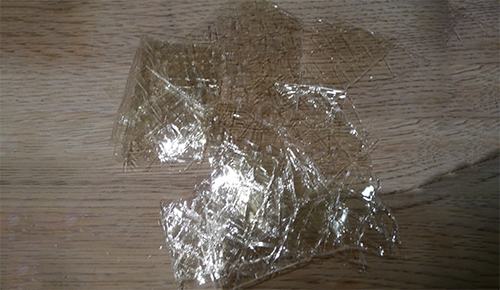 Check the pack for quantities and work according to the instructions (they can vary).
Check the pack for quantities and work according to the instructions (they can vary). 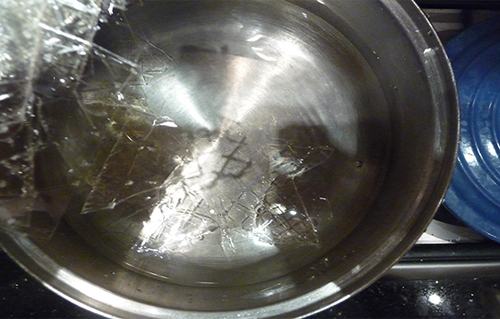 Allow to cool.
Allow to cool.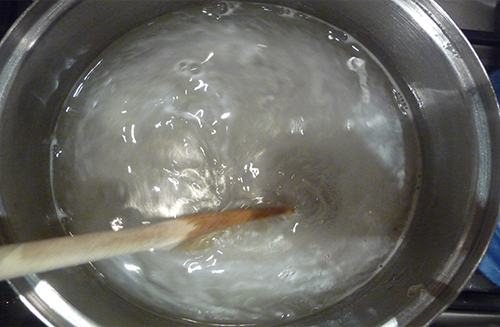
2. Gently place your clean eggs, pointed end down if possible, into the crock. We’ve used a glass preserves jar for the purpose of this guide, but an opaque one is better for long-term storage.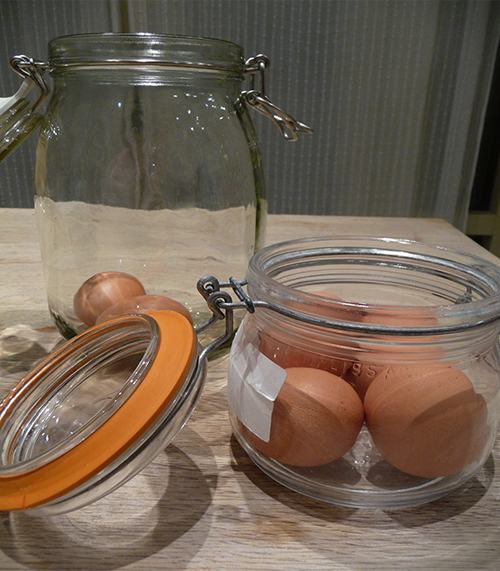
3. Pour the isinglass into the crock, ensuring that the eggs are completely submerged.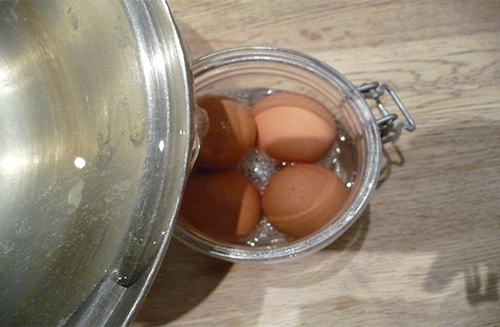
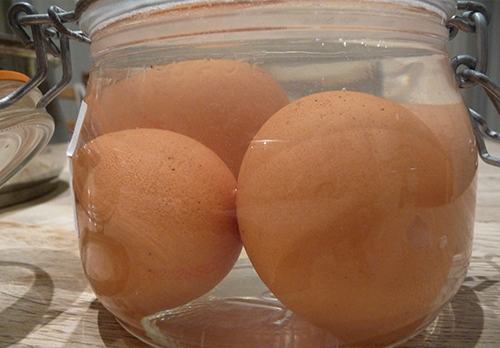
4. Leave to set to a slightly loose, jello-type consistency before placing on the cap or sealing.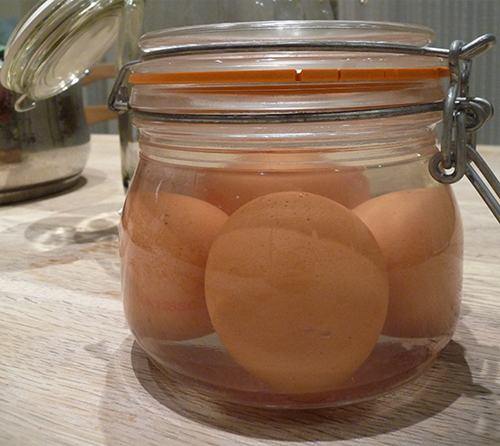
5. Store and use eggs as needed.
You can make your own mind up on this, but some people say that eggs preserved in isinglass can taste a little ‘chalky.’ However, the flavor improves greatly when cooked into a recipe or flavoured with herbs and the like.
Related: How to Make Powdered Eggs
That’s arguably a small price to pay for being able to preserve fresh eggs in pantry conditions. Keep your store of isinglass eggs in a cool, dark place and remove each egg from the pot as needed. Kept in this way, expect a shelf life of 6 – 12 months. It’s worth noting that the shells may become more fragile as you approach the six-month point.
If one of your preserved eggs hasn’t stored well and smells bad, it might be as a result of a hairline crack in the shell. Don’t fret it. Ditch the bad egg and try the others – one spoiled egg won’t affect the remaining ones.
You may also like:
C anning Amish Poor Man’s Steak
anning Amish Poor Man’s Steak
World’s Smallest Battery Powers House For 2 Days (Video)
How to Make Dandelion Bread (With Pictures)

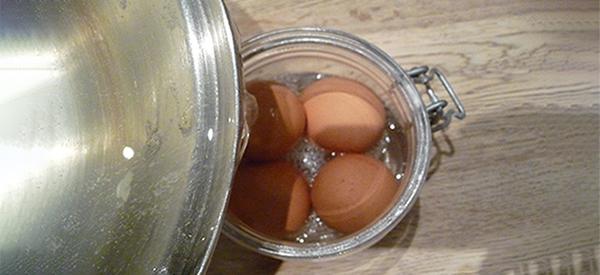










What about coating them with paraffin wax? I have heard this works as well.
Also mineral oil, but not sure that is for long term.
They’ve said mineral oil will keep them for a year. hn they had this survial program on tv that was one of the things they mentioned.
I tried that–didn’t work for me.
Tried WHAT?
Assume from context that mineral oil was tried, not paraffin wax. Anything which excludes oxygen and new bacteria likely to help for a time.
Initial article is misleading: Use water-glass. A silicate.
Not Isinglass. Made from fish proteins; proteins attract bacteria and various critters.
Or eggs may be pickled. By boiling just enough to sterilize shells, letting cool in boiled water, and then putting unpeeled into jars, which are then filled to brims with vinegar and sealed.
Some breakage inevitable, so you may peel instead and then immerse eggs in vinegar..More peeled eggs may be squeezed into jars. Favorants may be added to vinegar. Aforetime pickled eggs were a snack feature on many American bars.
Use freshest eggs you can find. There’s a tiny sticker on the back / side of each carton which gives the day-number of the year of production.
What the hell is a ‘Favorant’?
Mineral oil….and isingglass–the shell of the eggs just deteriorated in 2 days.
But doesn’t how long the eggs last in storage depend upon how fresh the eggs were from the gitgo? With store bought eggs, they have a “best by” date but no indication of when they dropped from the hen. I don’t know the answer to my questions, but I have heard that preserving works best when the eggs were laid this morning. No matter whether it is paraffin or mineral oil.
Eggs for the retail shelves are scrubbed to the point of breakage – takes the protective Nature’s “bloom” off the eggs …
Preserving eggs? – get that relationship established NOW with the egg ranch or small farmer – could be your own personal gold mine in a SHTF ….
Has anyone tried the lime method yet?. I hear from homesteads that you can keep up to two years..I would like to hear back if anyone had done this method yet
There is a law that requires the actual date that the eggs were packed in the carton, It is a 3 digit number that co-incides with the date of the year. I got a calendar that says what each day is ex: jan 1 would be 001 while Dec 31 would be 365. It’s there! and gives you a good idea of how old the eggs are when you buy them.
Problem with store bought eggs are that they have been washed. Thus taking a natural protectant off the egg.
I have heard store bought eggs, fresh from the store, can be about 6 weeks old already. I wouldn’t trust any of those eggs to store.
If you buy eggs from the store and they are $ .99, they are about 9 months old. Oiled of course but still about 9 months.
There is a code on the egg carton that tells the day of the year when the egg was packed and that should be withing a day or two of laying.
It is interesting to note how eggs have gone from good for you every morning (when I was a kid) to evil cholesterol generating spawn of the devil back to “An egg a day is good for you. The perfect food.”
Yea this has to do with too many scientist having nothing to do but plenty of money for R and D at schools who get money from our tax dollars. Shoot, they may have been given a little under the table to come up with research that helps a business man make millions of dollars who gave money to certain campaigns. Just never know these days.
left coast chuck, As I’m sure you well know, There are those people that just can’t stop telling other people how they should live their lives. They are known as liberals, even though that word was actually co-opted by the liberals and used to mean libertarian.
(which goes to show that they know they are wrong.)
In any case they love to use words and phrases to fool people into obedience, words like “science” and “expert” and phrases like “sell by date” and “climate change”.
These people are really authoritarians and statists and they are not above lying and force to obtain their ends, (a.k.a. pragmatism).
Solution? well, I do my OWN homework, try new things and tell those people to pound sand…just sayin’.
Sounds like intellectual snobbery to me, fella. Align with the hippie, and not the suits and be better off in the long run. Just saying….
Well said Vocal Patriot.
Ancient Chinese also buried (and now modern countryfolk immure) duck and other eggs in special clays. Yolk turns very dark, and egg is sulfurously pungent, but edible with northern Chinese and Korean dishes.
VocalPatriot summation: “Do your _own_ research and trials. Never trust an American ‘liberal’.”
Amen.
well you are wrong as usual. you use the word “liberal” like a bad word. you sound like a tired old trumpet. I’d rather be called a liberal than a trumpet azz-likker he’s gone, get over it. he’s out looking for a diaper to put on.
I long ago decided that if the powers that be like it, it is good for you. If they do not like it, it is bad for you.
We use the leftover beet juice from pickled beets along with more vinegar to pickle the eggs. It gives them a sweet plus vinegary taste. I prefer them this way over just straight vinegar.
Eat those wonderful eggs but at the same time enjoy your juice, …
1 Jar Manichevitz Borscht beets and beet juice (other brands work just fine such as; Golds. This is a jar of beet juice with some small amount of beets added that have been grated/diced very fine. I usually find it in the Jewish foods section in Publix.
2 Cans sliced pickled beets (they need to be diced kind of fine. Save the juice. I use the Walmart brand).
2 Cans sliced beets (not pickled and they need to be diced kind of fine. Again, save the juice. Walmart brand).
2 Bottles of Clamato juice (Picante is best because of the spices).
1 Bottle of clam juice.
4 Tablespoons of Worcestershire sauce (careful)
2. Tablespoons of Cholula hot sauce (this sauce is milder than Texas Pete or Tabasco and does not have a strong chili pepper taste).
A few dashes of Onion powder.
A few dashes of Garlic powder.
A couple dashes of Celery seed / salt.
Finally, add 2-3 cups of Vodka. Remember, this is not intended to be a drink that will result in your getting “soused” after each glass. It really is a drink that has healthy end results. So, do little taste tests when adding the seasonings and the Vodka to make sure it meets your taste buds standards. Adjust accordingly.
In a LARGE container (large enough to hold all of the above), add the beet juice, beets (dice the beets anyway you desire. Sometimes I do it manually with a sharp knife, then again I have used a blender, pulsing them until they look small enough for me (about 1/4 inch dices)) add the Clam juice, Clamata juice Worchestershire sauce, Cholula hot sauce, Garlic and Onion powder. Stir until well blended doing taste tests and adjusting if needed. You can use a can of spicy V/8 juice to adjust the taste but be careful because you do not want to over-power the nice taste of the beets. After you have the mixture “lab ready”, it needs to be canned/jarred up. I do it about anyway that will get rid of whatever containers I have available (gallon juice jugs work ideally). Now if you store it in the refrigerator, make sure no little “rug rats” that have a thirst craving does not get into your beet concoction and cause a stir.
This is how I prepare myself a nice drink;
Add a few cubes of ice to your glass and then add 1/2 glass of cold seltzer water (Perrier is great) to each glass of juice (50-50).
Let me warn you about this wonderful concoction. It is a good idea to not advertise this to many people because you will find yourself making a batch too often.
This drink could have potential in helping high blood pressure and high cholesterol into a descending glide path after a short time of consistent use.
Enjoy
I don’t eat gluten, so my cholesterol is fine. we have a saying, if it ain’t deep-fried, is it food? For some reason it makes my doctor want to pull his hair out. But, not eating gluten means I can’t have gefelta fish, either, worse luck. Some day! But, one quart beer, clamato juice, mix with lime juice to taste, very tasty health food a los Mexicans. Make your own hot sauce by grinding up (wash and stem them first!) and packing in canning jars. Ferment it till the skins and seeds rise to the top and it turns into salsa picante, pepper vinegar. It will store on the counter top. the seeds and skins are called pepper relish. Peace!
Dental lab supply houses sell “separator” “tin foil substitute” or may just call it “waterglass”.
Good thing about yard eggs is they will last weeks if you don’t wash them after collecting them daily
Can you use the isinglass more than once, or do you need to keep buying more? (Not easy to do when the SHTF.)
Paraffin wax is easy to get at just about any grocery store. It also has many other uses. Start stocking up on this. Each pack of wax runs about four or five dollars so may want to compare prices. Wax is easy to melt and apply.
My research on egg preserving always indicated Waterglass (sodium silicate) was used in the War to keep the eggs. I’ve not seen mention of Isinglass but I’d be keen to see the results after 6-12 months.
http://www.1900s.org.uk/1940s50s-preserving-eggs.htm
This page has a pic of an original tin.
For the best article that I’ve found on long term egg preserving look at the Mother Earth News page which shows various methods and the long term results of their experiment.
http://www.motherearthnews.com/real-food/how-to-store-fresh-eggs-zmaz77ndzgoe
Ginny, read that Mother Earth article, really informative thanks for sharing
my mother was born in 1916. I was always interested in the old ways. so I ask her several years ago what they used for eggs when their chickens were molting. she said they put any extra unwashed eggs they had before they started molting into a jar or crock of vinegar and they would keep 6 months or so. as long as the shells were not cracked they were like fresh eggs.
isinglass is made of egg whites so you can use some of your own egg whites to make
I’m certainly no isinglass expert but Wikipedia indicates as this article did that isinglass is made from fish bladders. Originally it was made from sturgeon bladders and the finest isinglass came from Russia. It was later discovered that isinglass could be made from cod bladders and that is the fish currently used. Isinglass is used in the manufacture of beer in England according to Wikipedia. It was an interesting read. There was no mention of egg whites.
I stand corrected thank you
Albumen is contained in egg whites, not to be confused with albumin which is a protein substance in human blood.
Albumen was used in making wet colloidal photographic plates back in the 1850s and 60s before the dry colloidal process was discovered. I know about this only because I read about it. Rumors that I know about it because I was around then are totally false.
Interesting..sturgeon.. the same fish russia gets caviar from.
Interestingly enough according to Wikipedia, Russian isinglass was considered the finest and Beluga isinglass was the creme de la creme of Russian isinglass. While I am not a big fan of caviar I understand Beluga caviar is supposed to be the finest caviar. No wonder the sturgeon is endangered. Fish eggs!! Where I come from we call that “bait.”
I feel the same way about sushi.
Ah, another use for mason jars!!
Do you need to refrigerate them for storage? I use Isinglass for beer making so I have it on hand
Refrigeration unnecessary, but always keep preserved foods from rapid environmental changes, e.g., soil moisture and temperature variations.
Prior country folk dug deep ‘root cellars’, or used dry caves, in which to keep preserved foods and to guard them from scavengers.
Site cellar on a relative elevation to keep dry, and line and roof it roughly with concrete or dry-laid rock. Completeness, not neatness, counts. Rule is same for mice as cats; if their head can fit through a gap, so may the rest of their body.
Build shelves using either solid wood, thickly-painted metal, concrete, or stone (ie. shale slabs). Hang points for sausages and corned (salted) meats useful. Don’t use mild steel fasteners or hooks unless thickly painted after installation.
Cellar/cave must have a strong well-fitted doorframe and door to exclude scavengers, e.g., bears, wolverines, badgers, raccoons. Leave no food residue whatever around any exterior area; if animals smell food, they likely dig for it.
I take my extra FRESH eggs, unwashed and rub them with mineral oil, place in cool dark place, they are good for up to 9 months.
I heard of people packing them in lard, like they do meat. A layer of grease, then one of eggs, then over with lore grease, then eggs. We never had to preserve eggs because we had a small commercial flock of RI Reds.
Water-glass. A silicate.
Not Isinglass.Made from fish bladders
Fats, sugars, salts, desiccation – all may be used for food preservation for varying periods, but never (safely) protein coatings or additives. Too many critters and fungi like to eat proteins.
Ever seen a fungus-encrusted French cheese?
Note that the term “isinglass” also means sheets of mica used as windows. Isinglass was commonly found as view ports on boilers and wood stoves before the development of heat resistant tempered glass.
Eggs preserved by a coating of wax or paraffin is found listed as “ship’s eggs” in old documents. Coating to prevent oxygen from enabling decay purports to give a six month to year shelf life.
The article I saw attributed the technique to be originating in Norse ships back to the 5th century.
You can find “larded eggs” listed as purchases for the military back from the U.S. Civil War. Whether the intent was long shelf life or as protection during shipping by wagon can be argued.
The key concept may be simply excluding oxygen from permeating the shell to extend shelf life.
BTW, shrink wrapped and gamma sterilized eggs have shown no decay after over a decade of storage just sitting on a warehouse shelf. (Product test on proposal for new type of military kitchen rations. started circa 1986)
Thanks, I didn’t know too much of that! Much better than one way friends from Asia told me, bury them in horse manure and they’ll keep quite a while. These are 1,000-year-old eggs, and don’t taste as bad as they look. BTW, lard or any grease will exclude oxygen, at least until the lard begins to oxidize.
Your Asian friends may be pulling your leg, and not gently. ‘Thousand-year’ eggs are buried in pure clays, not manure.
(I’ve been to Chinese stores where the eggs are yet in the original burial vessels with some clay still clotted inside. Discerning Asian shoppers also are suspicious, and like their fish still swimming.)
1K-year eggs taste great when sliced onto well-steamed spinach or any Romaine-lettuce salad.
Dehydrated lime in water with unwashed eggs, I have heard, will keep them good for over a year
I regret that I will have to leave your mailing list far too many of your blue links don’t work
My friend who sailed on a tiny boat for over a year said eggs don’t need refrigerated as long as you turn them every day. I don’t know how long they last that way but I have had them last at least 3 days without refrigeration.
I raised chickens as a 4H project. We had more eggs than we could use and my grandmother (born 1884 and raised on a farm) always kept them in a cool room. She said they were Ok that way and I don’t remember any going bad.
When I was a kid, back in the 60s, we kept farm eggs up to a month in the house basement (dark, cold, damp) and the egg buyer for the store called them fresh.As long as not cracked or dirty, they can be kept longer. I keep them for weeks more. If they get too ‘old’ then they get boiled and pickled. Niio!
Unfertilized uncracked eggs may keep for days in cool constant darkness. Don’t know what daily turning would do, but could be useful inspection.
If you want for egg proteins to keep for months/years, powdered eggs kept in sealed containers will.
I’d worry about getting them dirty from my hands. When we had a small commercial flock in the early 60s, they were inspected and put in wire baskets, and stored in the house cellar. The egg buyer came once a month and called them farm fresh. The thing was, we did not touch the eggs except that one time to inspect and put in the baskets. Too much bacteria on the shells, and hands. And, they had to be cooled slowly or could draw bacteria in, thru the shell. niio
I have to ask- saw the photos of the ‘sheet of isinglass’ as it was melted down to liquid form, then set to cool before placed over the eggs in the canning jar. I cannot find the isinglass in that type of form on the market, only in liquid form- does anyone know where it can be purchased in the ‘hard form’? Thank you.
Thanks…isinglass didn’t work, so I’ll try water glass.I have access to fresh eggs right from the chicken.
Has anyone tried waterglassing eggs? Did this process work and will it work for fertilized eggs? I have 12 laying hens and a rooster for their protection and he does “ service “ them! I provide the neighborhood with fresh eggs but would like to keep some for later use just in case of SHTF. Any advice on this would be appreciated
What is the ratio of isinglass to water and what form of isinglass is right/best? How do I preserve isinglass for future use on eggs since if the SHTF and I can’t buy eggs, presumably I can’t buy isinglass either.